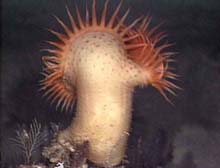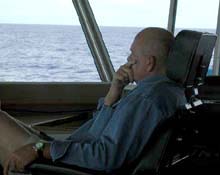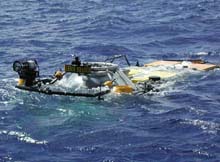“The Oceans are Different”
August 30, 2002
Paula Keener-Chavis
National Education Coordinator/Marine Biologist
NOAA Office of Ocean Exploration
We shall not cease from exploration. And the end of all our exploring will be to arrive where we started, and know the place for the first time.
--T.S. Eliot
In his book entitled, The Biology of the Deep Ocean, author Dr. Peter Herring – and scientist on this final leg of the Islands in the Stream 2002 Expedition – writes, “I find the inhabitants of the deep ocean to be a constant source of surprise and delight. Every time we think we understand the ecosystem and the organisms, they manage to produce a new rabbit out of the oceanic hat, so that we are required to readjust our previous perspective.” (Herring, 2002)
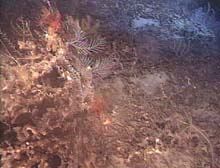
Lush bottom cover almost suggests a shallow water coral reef, except it exists in over 2,000 feet of water off the Florida coast. Click image for a larger view.
Indeed, this final leg of a deep-sea odyssey has managed to produce a few more “rabbits out of the oceanic hat.” Discovery and explorations over the past 13 days have enabled us to see parts of our world previously unknown. We have only begun to more fully know, let alone understand, the deep coral reefs in this area and the multitude of other rich invertebrates that clearly must comprise one of the most biologically-diverse areas of our ocean. It has been a rare privilege to see coral pinnacles towering hundreds of feet up from the ocean floor, elegantly dressed in beautiful sponges, other hard and soft corals, crinoids, anemones, sea stars, and urchins. Crabs, shrimp, octopi, squid, scorpionfishes, hagfishes, hake-like fishes, rattails, and sharks have all managed to make this place on the planet, thousands of feet beneath the surface of the ocean, their home despite the crushing pressure, blackness of night, and frigid temperatures.
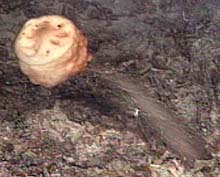
An unusual hexactinellid sponge that anchors itself in the sediment with elongate spicules. Click image for a larger view.
We have found at least half a dozen new species of sponges, and preliminary microbial assays indicate some biological activity, making some of them potentially valuable for pharmaceutical use. We have mapped new areas of the ocean floor, expanding our knowledge about the structure and orientation of deep coral reefs and the rich biological communities associated with them. We have explored with state-of-the art technologies placing humans directly into one of the most extreme environments on Earth. We have explored bioluminescence with new technologies and investigated vision in deep-sea animals using new collecting gear. We now understand more about how to make these sampling methodologies more functional in the deep sea.
We are all the richer for these multidisciplinary endeavors to explore and more fully understand our ocean world. And this does not include intellectual explorations that have taken place among those on board the Seward Johnson as scientists, educators, and ship’s crew representing eight different countries and a multitude of disciplines worked together, analyzed together, learned together, and discovered together aboard their tiny shared home on one enormous ocean.
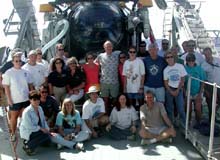
The explorers of Leg 3 gather for a final photo in front of the Johnson-Sea-Link II submersible. Click image for a larger view.
As we begin to pack up gear, secure samples, and prepare for flights home to our lives and our families on terra firma, Peter Herring’s words again come to mind at the conclusion of this Voyage of Discovery: “We are components of the terrestrial ecosystem and so we are inclined to assume its structure is the norm and can be used to interpret the oceans. We have already seen that the scale of the oceanic ecosystem makes this a dangerously self-centered assumption. The oceans are different” (Herring, 2002). Indeed, they are.
References:
Herring, P. 2002. Oxford University Press. The Biology of the Deep Ocean, .
Interview with Ralph van Hoek
Captain, R/V Seward Johnson
What are your responsibilities on the Seward Johnson?
I am responsible for getting the scientists to and from the different work areas and back home safely. Along with the Chief Mate, I am also responsible for ensuring that all ship operations are carried out, including ship maintenance, and ensuring that the scientists get the help they need from the ship’s crew.
How did you get interested in this work?
I have been around boats all of my life. My grandfather lived on a barge in Holland and he carried freight on it and my father was born on that barge. My father owned a marina in Ft. Lauderdale and I had boats growing up.
What do you like most about your position?
I like meeting new people, doing different things and sometimes we get to visit exotic ports, but not too often.
What do you find challenging about your work?
The weather can be challenging. Constant changes in rules and regulations can also be challenging. New equipment and different methods of sampling from cruise to cruise can be challenging at times when you try to keep everything running smoothly so the scientists can get their work done. I really like my career though, in spite of the challenges.
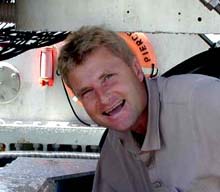
Dr. Eric Warrant leaves the Johnson-Sea-Link II submersible after a dive to the bottom of the ocean in 750 meters of water. Click image for a larger view.
Interview with Eric Warrant, Ph.D.
University of Lund, Sweden
What is your area of interest during the Expedition?
Tammy Frank invited me to come on this Expedition to conduct the same kinds of experiments she is doing on crustaceans but on deep-sea fishes. I take a piece of the retina and put two small electrodes onto it to record electrical signals in the retina that result from stimulation with light. By using different colors of light, I can find out what range of colors fishes can see. By using flashing lights of increasing flash frequency, I can find out how fast the eye is able to see. The purpose of my research is to find out what kind of things deep-sea fishes should be able to see in the very special environment in which they live and to find out whether or not the eyes are optimized for seeing flashes of bioluminescence.
How did you get interested in this work?
I went to the University with a childhood fascination for animals. I had never studied physics prior to entering the University but was forced to do so before I started my studies there, and then I fell in love with physics. My degree turned out to be a perfect marriage between the fascination for insects and my love of physics and I double majored in entomology and physics. That led to an interest in optics and eye design in insects and finally, all animals. I have always worked on eyes, but those of insects mostly. A couple of years ago, I was asked to join a cruise working on billfishes and tunas and as I am doing on this expedition, I used previously untested methods at sea. Because my main interest is how well animals see in very dim light, extending the experiments on billfishes and tunas was an obvious next step.
What do find most interesting about your work?
The chance to travel to weird and unusual places to work on insects, without question, is what I find most interesting. The lives of the animals themselves really keeps me going. To figure out how they live and solve the problems of their daily lives is so rewarding. In fact, the chance to come on this Expedition and go down in the submersible is something I never dreamed I would be able to do and is an event in my life that I will remember forever. It is certainly one of the highlights of my life. Being able to see the animals in their own environment with my own eyes instead of just from a textbook is like going from two dimensions to three dimensions.
What do you find most challenging about your work?
Adapting modern methods to the field environment can be extremely difficult as I try to create a lab environment where the animals are. This is a huge challenge technically and logistically, as my work takes me from oceans to jungles.
Sign up for the Ocean Explorer E-mail Update List.















































